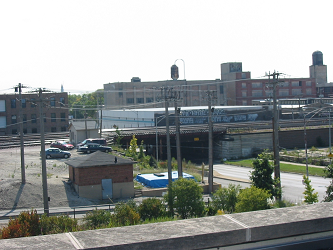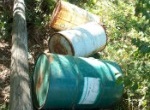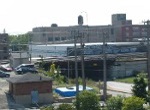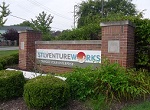Brownfields Problems and Redevelopment Opportunities
Last Reviewed: July 7, 2025
Are you worried about what's in the soil or the air around a nearby vacant industrial site? Do you suspect the worst about the condition of the building itself? Did the departing business leave behind a few old barrels? Then you are probably dealing with a brownfield right in your neighborhood.

According to the U.S. Environmental Protection Agency (EPA) definition, a brownfield is a site where redevelopment is complicated by possible presence of a hazardous substance, pollutant, or environmental contaminant.
The EPA, the focal point of brownfields work in the U.S., says there are probably 450,000 such places in the U.S., with estimates for Europe as high as 3.5 million. Most countries with any environmental consciousness or history of respect for land have some version of a brownfields program.
One of the authors contributing to this website has extensive experience in working with the wonderful but frustrating system of brownfield remediation (clean-up), which can be frighteningly bureaucratic. In his opinion, the fact that relatively few contractors and consultants work within federal brownfield programs in any given region of the country means that these firms tend to monopolize information, keeping it away from activists, planners, citizens, and even economic development officials.
We should note right away that European nations do not share a common definition. In Great Britain, for example, "brownfields" simply means developed land. On this site we are describing sites where actual or possible soil contamination has occurred.
Site cleanup and redevelopment can be a truly interdisciplinary effort, and in our opinion, it should be just that. Projects include aspects of environmental science, land use planning and regulation, and public health. Often an argument can even be made that these cleanups are part of community beautification.
Without question, the best remediation efforts ultimately lead in the long term to the potential for economic development. Often in fully built-out cities, brownfields offer some of the best prospects for assembly of land for new housing, commercial, or institutional development expansions.
The problem with ignoring brownfields is that developers walk quickly in the other direction if they even
suspect an environmental issue. They have heard that buying a polluted site, or merely one where pollution is suspected, is legally risky. I even experienced a developer my department often found to be sympathetic walking away from me in anger after I suggested he take a look at one such site to see what he thought. It took him about four months to want to be friendly again.
Some of you are thinking that you couldn't possibly have any brownfields in your community because you've never been an industrial town or suburb.
It's best to reconsider, because if you ever had a gas station, automotive repair garage, tire store, agricultural processing of any type, lumberyard or lumber processing operation, dry cleaners, industries, silverplating, mining, milling, power production, chemical storage, petroleum storage, or industry, you have properties that need to be considered.
To understand the full extent of the issue, visit the EPA brownfields site. We give great credit to EPA for beginning to use the term land revitalization in conjunction with brownfields. The distinction they make is that land revitalization concerns putting the cleaned properties back into use. This means that communities should proactively consider likely future uses of the land in determining the best cleanup process. So if you hear about land revitalization, realize that it is a newer umbrella term that includes brownfields as one part.
Some of you are thinking that your brownfields are the "worst of the worst." These are called Superfund sites. These sites were identified in a major search for old contaminated sites that followed the passage of CERCLA (the Comprehensive Environmental Response, Compensation and Liability Act) in 1980. EPA now includes the CERCLA properties under its land revitalization description.
Waste at abandoned sites must be cleaned up by the responsible party, or if that party can't be found or can't pay, the federal Superfund can clean up the site.
We're being arbitrary about distinctions here, but we chose to cover Superfund sites under toxic waste page.
Benefits of Brownfields Redevelopment
Cleaning up and reinvesting in brownfields typically provides numerous community benefits, at least when the site is located somewhere within the built-up area of a metro area. We think these advantages include:
- Increasing overall appeal and attractiveness of the community for economic development
- Removing any public health or environmental threat that may linger
- Reducing blight and housing decline in the immediate area
- Increasing nearby housing values from 5 to 15 percent, according to a University of Chicago study
- Increasing local tax revenues
- Thwarting of sprawl by providing building sites closer to the urban core
- Allowing areas closer to the center of the city to embrace new architectural and development trends without harming the historic street pattern
- Allowing redevelopment to take advantage of existing infrastructure (streets, utilities, and so forth)
- Facilitating incorporating energy conservation and other sustainable development practices into development projects
- Promoting higher density and intensity development in many cases
- Conserving open space at the edges of the city, thereby reducing the many negative effects of sprawl
- Adding currently in-demand jobs in areas in need of replacement opportunities for workers formerly employed in manufacturing
- Creating clean-up jobs
- Promoting climate resiliency by reducing vehicle miles traveled as sites are redeveloped.
Government Assistance in Brownfields Redevelopment
The EPA holds a lot of the cards in this game in the U.S. because they are both a regulatory agency and a grant-making and loan-making entity with regard to polluted sites. The Bipartisan Infrastructure Act of 2021 included about a boost of about $1.5 billion to the existing EPA brownfield programs. The grants and loans divide into three primary categories, which are described below. A few other grants of less interest to our audience are also available.
• Assessment grants for inventory, testing, and planning are available to applicants that are governmental in character, as well as non-profits with a 501(c)(3) designation. Read the fine print in the rules for other distinctions about eligibility.
There are three types of assessment grants. A community-wide grant may be requested, with a maximum of $300,000 available when a community does not have a specific site in mind and expects to work on more than one site.
The site-specific grant pertains to one specific site and cannot exceed $200,000 unless a waiver is obtained based on the size or complexity of the project.
A coalition assessment grant allows a lead organization to partner with one or more organizations having a lesser capacity for carrying out the assessment. The maximum funding for this type of grant is $600,000. Many neighborhood associations would need to find a major environmental organization that could serve as the lead organization while tackling a site of concern to the neighborhood.
• Grants to capitalize a revolving loan fund for actual cleanup are available, but again, only government types, not nonprofits, are eligible to apply. Historically there have been few new grants each year, with no new grants awarded in some fiscal years. So the trick is to find out who in your community or metro area already has been funded for a revolving loan fund, and try to get in line for the next revolution of the door. Nonprofit organizations can receive funds from an existing or new revolving loan fund in your locale.
• Cleanup grants fund the physical labor and materials necessary to make the land safe to use again. A neighborhood organization or any other type of eligible entity must own the land to apply. Governments and tribes are of course eligible. The grant is up to $500,000 per site, with each applicant permitted only one application for cycle of competition. A 20 percent match is required, but may be waived for nonprofits.
As a word of warning, of course government programs can and do change all the time, so watch out and verify everything we have said. It could change tomorrow, especially with the rapid pace of governmental change we are seeing in 2025.
And yet another warning is that brownfields aren't do-it-yourself projects for small local governments or for nonprofit organizations. You might actually write quite a good neighborhood plan on your own, but there's not a chance that you can successfully compete for, receive, and satisfactorily complete an EPA brownfields grant without a consultant.
Maybe you're lucky, and you have a consultant nearby who will help at a reasonable rate. After the funding is in place, EPA encourages and even requires community involvement, but you can't get there by yourself.
Now that I've convinced you that EPA is the place to go, let's muddy the waters by saying that HUD (the U.S. Department of Housing and Urban Development) became interested in redevelopment of such sites in the early 2000s, and they sponsored the Brownfield Economic Development Initiative grant program, but alas, BEDI as it was called has now been killed. So it is conceivable that another agency might become involved in the brownfield question in the future. We would hope that public health entities especially could become more engaged in this issue.
The short message here is there's hope. There's money for
clean-up, and the EPA will help you force the responsible party to clean
up the site. Or they will put you on the list for federal clean-up if and when
there's ever money. The new cash infusion from the infrastructure bill won't even begin to meet all of the financing needed to clean up the worst sites, so you have to be scrappy and persistent to get some dollars for your community.
States also have voluntary clean-up programs. These may provide financial and/or technical assistance to property owners who want to clean up soil, spills, or waste collections on their properties but aren't under any federal requirement to do so.
From this discussion you might think it was somehow illegal, immoral, or impossible for a developer to clean up a contaminated site. In all seriousness, property owners may choose to clean up their own messes, using qualified professionals of course, if they are so motivated. And you may buy a contaminated site, and clean it up yourself.
The Small Business Liability Relief and Brownfields Revitalization Act of 2002 (called just "Brownfields Act" many times) spelled out precisely what one must do to conduct "All Appropriate Inquiry" before purchasing brownfields, tells about appropriate professionals, and potentially limits liability of buyers of contaminated property.
What Should the Community Do About Polluted Sites?
• The community can have an outreach program to businesses to encourage them to identify their own issues and fund a cleanup and restoration. The local government needs to become engaged in making sure that businesses take advantage of any and all funding opportunities for cleanups.
• In the case of abandoned industrial or commercial sites, the local government can be helpful by purchasing the property and presiding over the cleanup, relying on other levels of government to provide funding and expertise. If the local government does not wish to assume ownership, the community certainly should locate funding for clean-ups of properties owned by inactive corporations. Especially if the site is located in a low- or moderate-income community, the community may be able to use Community Development Block Grants to address the issue.
• Citizens and community groups can engage in a mini-planning process in which they think through the ideal land use of the property. It's possible that after testing, you may decide that it's not economically feasible to clean up every portion of the site to a degree where residential development will be possible. So it's a good idea to identify several alternatives.
• In fact, we urge neighborhood associations to have their own little brainstorming session about proposed new land uses when their city does not take enough interest in a problem property in their neighborhood. When a neighborhood we were working with did this, they obtained time on the city council agenda to present each councilperson with a neatly bound report folder of their findings. While this is no way substituted for professional evaluation studies, it did shame the council into taking more interest in the problem.
• There's a business opportunity in flipping brownfields sites, and a few companies are doing that. You can advertise for investors and see if you find any takers.
If you're the neighborhood on the outside looking in at this process, it can seem to move very slowly indeed. But persist. If there's a federal agency involved, they have to give you information, but the speed at which you're answered often depends on your own diplomatic skills and persistence.
The ultimate goal of a cleanup or an environmental investigation is called a "no further action" letter, in which some level of government certifies that no further action will be necessary.
Now it's time to get going. If your community can afford it, clean up your polluted sites even when you think there's no market, because cleanup will improve the quality of your groundwater. And remember, cleaning is easier the sooner you do it.
Read More About Related Topics
Join GOOD COMMUNITY PLUS, which provides you monthly with short features or tips about timely topics for neighborhoods, towns and cities, community organizations, and rural or small town environments. Unsubscribe any time. Give it a try.




